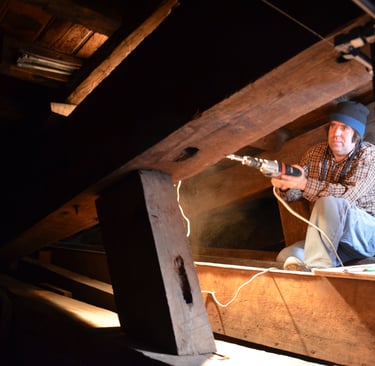Dr Daniel Miles FSA
Daniel Miles has long been interested in many different aspects of historic timberwork, architecture, and conservation, becoming a life member of the SPAB in 1977. Although studying architecture beginning in 1978-9, he never completed, becoming disillusioned with modern architecture. Instead, he concentrated on the practical aspects of architectural history and in 1979 became a partner in a firm based in Mapledurham, Oxfordshire, specialising in traditional building techniques. Wanting to further study vernacular architecture, he first studied dendrochronology under the pioneer Dr John Fletcher of Oxford University in 1986. After his death the following year, training continued at the Ancient Monuments Laboratory of English Heritage, and still continues to work as a commissioned contractor for the body now known as Historic England.
Society memberships have included:
Royal Archaeological Institute (up to 1995); Society for Medieval Archaeology (from 1994); Association for Studies in the Conservation of Historic Buildings (ASCHB – since 1989), Society for the Protection of Ancient Buildings (SPAB – Life member since 1977), CBA South Midlands Group (9); Devon Buildings Group; the Vernacular Architecture Group (since 1986, Committee member 1990-92); AVISTA, South Oxfordshire Archaeological Group (past Chairman) , and the Listed Buildings Committee of the Oxford Architectural & Historical Society and agent for the Council for British Archaeology (since 1988). Was elected Fellow of the Society of Antiquaries of London 2005.
Partner


In 1987 he set up Miles & Company which specialised in historic conservation and timber recording, with projects that included the Tower of London, Windsor Castle, Salisbury, Winchester, Wells, and Brecon cathedrals, and various buildings at the University of Oxford. From 1988-1991 he was employed by Nottingham University as fieldwork co-ordinator and recorded over 100 cruck-framed buildings in the Midlands, as well as contributing to the Medieval Peasant House in Midland England (Alcock and Miles 2013).
By 1998 the Oxford Dendrochronology Laboratory was revived as a partnership, and at the same time, a post was taken at the Research Laboratory for Archaeology and the History of Art (RLAHA), Oxford University. Here, responsibilities from 1999 included the tutoring of MSc students in Archaeological Science, as well completion of his DPhil in 2005 on the further interpretation of tree-ring dates in historic and vernacular buildings. Research at Oxford has included work with Neil Loader of Swansea University in developing isotopic dendrochronology, which still continues. In 2010 Dr Martin Bridge joined the ODL as a full partner, after having worked with the Lab for many years previously. At the same time a purpose-built Lab and archive was constructed.
Dendrochronology projects he has personally developed included a variety of projects for the National Trust, Historic Royal Palaces, University of Oxford, Salisbury Cathedral, Westminster Abbey, and the Houses of Parliament, as well as a number of studies in New England and the Mid-Atlantic states of the US.
